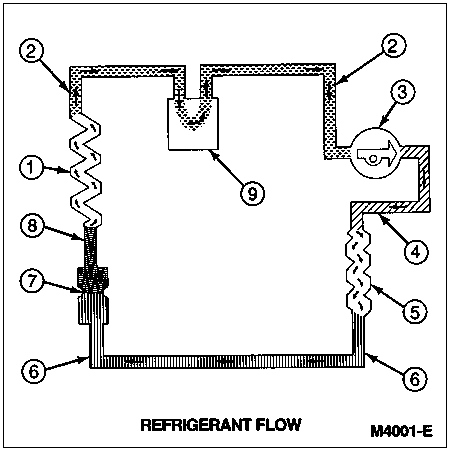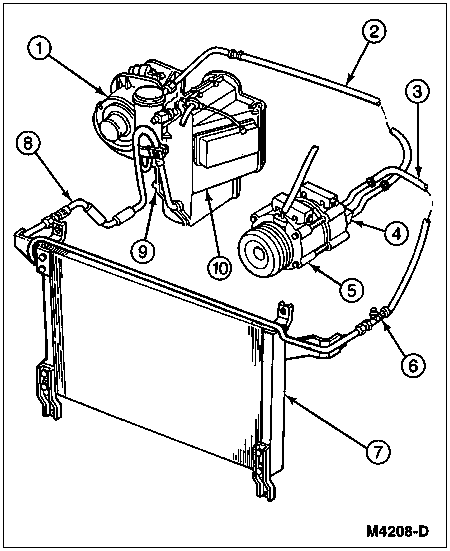Refrigerant Flow

Section 12-00: Climate Control System, Service | 1996 F-150, F-250, F-350, F-Super Duty and Bronco, F-Super Duty Motorhome Chassis Workshop Manual |
Refrigerant Flow

| Item | Part Number | Description |
|---|---|---|
| 1 | 18527 | Blower Motor |
| 2 | — | Suction Line (Part of 19D734) |
| 3 | — | Discharge Line (Part of 19D734) |
| 4 | 19D734 | A/C Manifold and Tube |
| 5 | 19703 | A/C Compressor |
| 6 | 19D890 | High-Pressure Service Valve |
| 7 | 19712 | A/C Condenser Core |
| 8 | 19835 | Condenser to Evaporator Tube |
| 9 | 19930 | A/C Blower Housing |
| 10 | 19B735 | A/C Evaporator Case Cover |
During stabilized conditions (air conditioning system shutdown), refrigerant system pressures are equalized on both the high and low pressure sides of the system.
Refrigerant Flow
| Item | Part Number | Description |
|---|---|---|
| 1 | 19860 | A/C Evaporator Core (Low-Pressure Liquid In, Low-Pressure Vapor Out) |
| 2 | 19867 | Evaporator to Compressor Suction Line (Low-Pressure Vapor) |
| 3 | 19703 | A/C Compressor (Low-Pressure Vapor In, High-Pressure Vapor Out) |
| 4 | 19972 | A/C Compressor to Condenser Discharge Line (High-Pressure Vapor) |
| 5 | 19712 | A/C Condenser Core (High-Pressure Vapor In, High-Pressure Liquid Out) |
| 6 | 19835 | Condenser to Evaporator Tube (High-Pressure Liquid) |
| 7 | 19D990 | A/C Evaporator Core Orifice (Restriction) |
| 8 | — | Evaporator Inlet (Low-Pressure Liquid) |
| 9 | 19C836 | Suction Accumulator/Drier (Low-Pressure Vapor) |
When the blower motor (18527) is on and the function selector lever is in any air conditioner DEFROST position, the A/C clutch field coil (2987) is energized and the clutch plate is pulled into contact with the compressor clutch pulley. The clutch plate and hub assembly then rotates the compressor shaft.
When the compressor shaft is rotated, the pistons are alternately moved back and forth with respect to their cylinder bores. As each piston is pulled through its cylinder bore, the pressure in the cylinder suddenly reduces to a pressure (or vacuum) considerably lower than the refrigerant system. The higher refrigerant system vapor pressure overcomes the suction reed valve spring pressure, forcing itself through the reed valve and into the lower pressure (or vacuum) area inside the compressor cylinder. The spring pressure on the reed valve closes the valve when the refrigerant system suction vapor pressure and the compressor cylinder vapor pressure are equalized.
As each piston is forced into its respective cylinder bore, the refrigerant vapors from the suction side of the refrigerant system are compressed into a decreasingly smaller area, thus increasing the refrigerant vapor pressure and also raising the refrigerant vapor temperature. The higher refrigerant vapor pressure now assists in sealing the suction reed valve closed and also opens the discharge (high pressure) reed valve as the cylinder pressure exceeds the higher pressure side of the refrigerant system. When the compressed higher pressure and temperature refrigerant vapor is discharged into the high-pressure side of the refrigerant system, the discharge reed valve spring pressure and the high side refrigerant pressure closes and seals the reed valve, thus preventing the discharge gas from entering the compressor cylinder. The compressor's refrigerant vapor compression cylinder then begins again.
The high-pressure and high-temperature compressor discharge refrigerant gas is released into the top of the A/C condenser core (19712), via the compressor's discharge hose. The A/C condenser core, being close to ambient temperature, causes the refrigerant vapor to condense into a liquid when heat is removed from the refrigerant by ambient air passing over the fins and tubing.
Liquid refrigerant from the A/C condenser core exits from the bottom of the A/C condenser core and enters the condenser to evaporator tube (19835) and then the inlet side of the A/C evaporator core orifice (19D990) located in the evaporator inlet tube. The inlet filter screen of the A/C evaporator core orifice removes coarse contaminant particulates, which may be present in the liquid refrigerant before the liquid refrigerant enters the calibrated opening of the A/C evaporator core orifice. The outlet end of the A/C evaporator core orifice has a fine mesh filter with four open side slots in the body of the A/C evaporator core orifice, upstream from the filter. This filter removes fine contaminants and causes some of the refrigerant to exit through the nonfiltered side slots. The side slots and filter act as a refrigerant flow noise suppressor.
Pressure in the A/C evaporator core (19860) is reduced as a result of air conditioner compressor suction. As the pressure is lowered and the condenser to evaporator tube pressure increases, the liquid refrigerant passes through the A/C evaporator core orifice and enters the A/C evaporator core at a low pressure and as a cold liquid. As airflow passes over the plate/fin sections of the A/C evaporator core, the refrigerant inside absorbs the heat and changes into a vapor.
Compressor suction draws the vaporized refrigerant and oil mixture into the suction accumulator/drier (19C836) where the heavier oil-laden vapors fall to the bottom and the lighter vapors and oil mixture continue their path to the A/C compressor (19703) via the top of the vapor return tube. A desiccant bag located inside the suction accumulator/drier, absorbs and retains moisture that may be circulating in the refrigerant system. The heavier oil-laden refrigerant also returns to the compressor through a small liquid bleed hole near the bottom of the vapor return tube. The liquid bleed hole provides a controlled oil amount to pass through the opening and to enter into the main vapor flow path to the suction side of the A/C compressor.
Refrigerant Systems
F-Series and Bronco vehicles offer the R-134a refrigerant system.
The A/C refrigerant system is an A/C clutch cycling orifice tube type. The system components are:
System operation is controlled by the following:
The refrigerant system incorporates a 10-cylinder A/C compressor controlled by an A/C cycling switch connected in series with the A/C clutch.
The A/C cycling switch:
An A/C compressor pressure relief valve is installed in the high-pressure side of the A/C manifold and tube (19D734) to protect the refrigerant system against excessive refrigerant pressures.
Operation of the A/C clutch is dependent on signals from the powertrain control module (PCM) (12A650). The system is programmed to interrupt A/C compressor operation when certain conditions exist. The A/C clutch can be shut off for several seconds:
An A/C evaporator core orifice is used to meter the flow of liquid refrigerant into the A/C evaporator core for passenger compartment cooling.